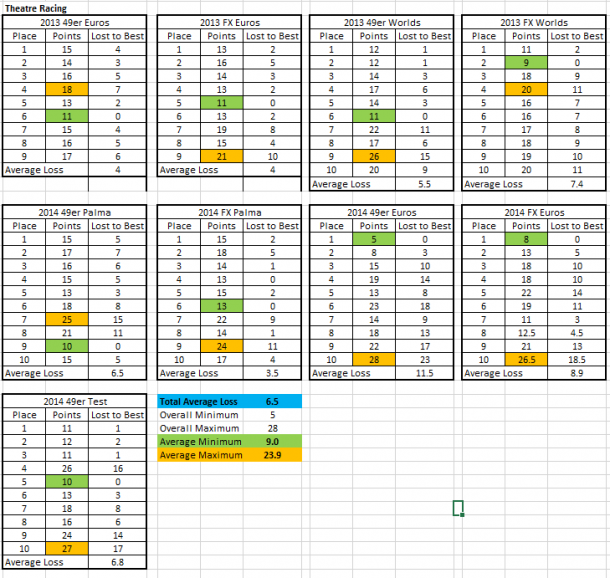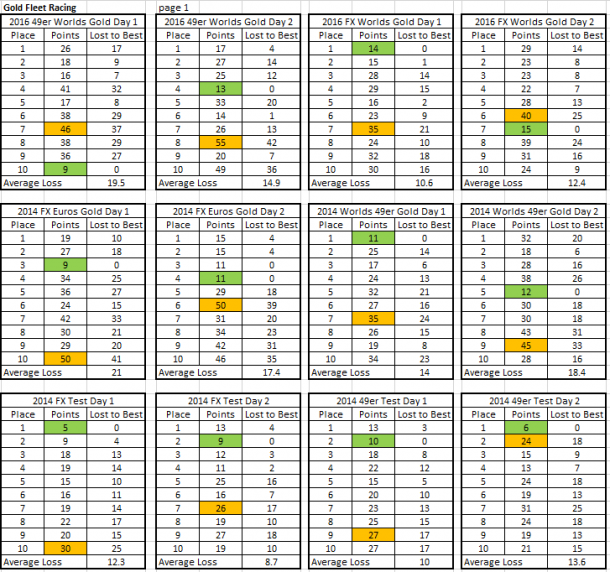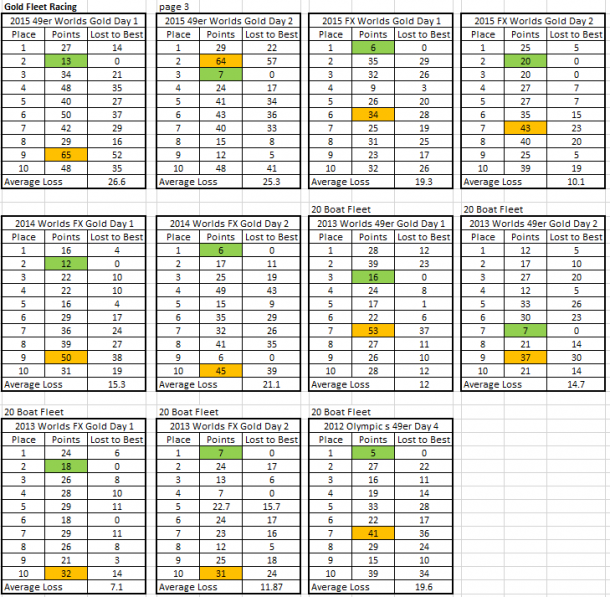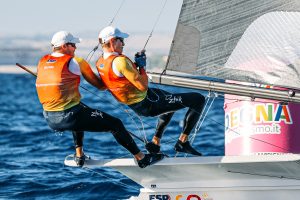In November 2016, World Sailing adopted a Theatre Style conclusion for the 49er, and 49erFX for Tokyo 2020. As such, the 49er Class formed a Format Working Party and is happy to introduce the following format for the 2017 49er Championships.
Qualifying
- 3 days with 10 total races scheduled, each race scheduled for 30 minutes target time.
- 1 drop after 4 races
- Windward – Leeward, favoring 2 laps
- Gate at the leeward mark and Gate at the Windward Mark
- Fleet size maximum of 35 boats (so 3 fleets at 71 total boats)
Gold Fleet
- Carry 1/2 of the qualifying points forward to add to all future race scores
- 2 days of 3 races per day, each race scheduled for 20 minutes.
- 1 drop after 4 races
- Windward – Leeward, favoring 2 laps
- Gate at the leeward mark and Gate at the Windward Mark
- 20 boats
Silver (Bronze) Fleet
- Carry 1/2 of the qualifying points forward to add to all future race scores
- 3 days of 3 races per day, except 2 races on final day, each race scheduled for 30 minutes.
- 1 drop after 4 races
- Windward – Leeward, favoring 2 laps
- Gate at the leeward mark and Gate at the Windward mark
- Fleet size of balance of remaining fleet(s)
Final
- Carry 1/2 of the qualifying points and all Gold Fleet points forward
- Final Day – 3 theatre races – 10 to 12 minutes target time
- Windward – Leeward, favoring 2 laps with boundaries at 60% length to width ratio
- Windward Gate at discretion of RO, Leeward Gate
- Top 10 boats in Final, have petit final if skiff only regatta, no petit final if with Nacra 17
For those interested in the background and discussion of how the executive and format working party arrived at this format, please read on:
Preamble
World Sailing approved a 3-race final day for the 49er, 49erFX, and Nacra 17 for 2020 in December of 2016. The classes are reviewing format and scoring options for the upcoming racing. It is important that the fundamental formats and scoring developed can work for the variety of regatta formats being used today so that there is continuity through the sailing season. The events we considered are:
- Major Class Championships
- Olympic Games
- Sailing World Cups
So that readers of this paper can get used to the language, here is a reminder of the format for Rio, which for the most part was acceptable:
A class championship in the skiff was a 6-day championship, with up to 10 qualifying races over three days, followed by three days of gold fleet racing and a medal race added to the final day if time allowed. Qualifying fleets of equal size and skill ranged from 20-35 boats in size, and points were carried forward. Gold fleet was 25 boats, with 30 minute races. One drop was deducted from the qualifying and one drop removed from the gold fleet. Finally, there was a 10 boat, 20 minute, and umpired medal race worth double points that could not be dropped on the final day so long as time allowed.
The compliment to this format was the Olympic format, which was a 5 day regatta. There were up to 12 races scheduled over 4 days in fleets of 20 boats. Races were 30 minutes long with the worst race dropped from a series scored. On the final day there was an umpired medal race with 10 boats, double points that could not be dropped.
Looking to 2020
A thorough review of all aspects of a format were reviewed, topic by topic. The following is a discussion of what was reviewed and/or considered for change
a) Final Day schedule – With the final day shifting to be a 3-race final, which we will call ‘Theatre Racing’ for simplicity, it was clear that we could not simply tack on this format ‘if time allows’ like was done with the medal race. To set up the course and have time to run the umpired races, a dedicated day is necessary.
b) Variety of Racing – Some within sailing have called for races to be more varied, in an effort to test a broader sailing skillset. While the skiffs have had a culture of short racing on the Olympic circuit, there is also a culture of scramble or tour races like the Sydney Harbour courses. There is also a long culture of large fleet and distance racing in multihulls. The skiff group decided there was other Olympic equipment better suited to varied courses and geographies, so the skiffs will stick to shorter races. The multihulls, however, may give longer race courses a try, at least in qualifying.
c) Duration of Regatta – with the Theatre requiring a full day, the 6-day championship was put under review. There was the option to add an extra day, however, the consensus view was to keep championships at 6 days long as that was considered enough racing. The Olympics is unaffected since they already used a whole day for the medal race.
Qualifying
d) Duration of Qualifying – 10 races over three days worked very well for skiffs 2013 – 2016
By allowing RC to go ‘one race ahead’ in good conditions and perform 4 races on one of the days, without then needing to pull back to 2 races on the last day if everything went perfectly, qualifying has been improved. There were a few times during the last quad when one day was missed, and teams therefore scored 7 races instead of 6 before the split fleet, which is a good outcome for the class.
While there were still tiebreaker splits between gold and silver, at least it was after a large enough number of races that most teams could point inwardly if they fell on the wrong side of the mathematics and accept their fate. As such, we recommend continuing with the same qualifying format.
Gold Fleet and Olympic Racing
e) Gold Fleet Racing was put under review. The Olympic races, at only 20 boats but still 30 minutes, seemed too long and lacking in intensity compared to normal skiff sailing. The concept tried in 2013 of having 20 boat fleets and 20 minute races was put forward. For a broadcast minded fleet the increased exclusivity and intensity was seen as a benefit. Race Committees should stretch the time target to 25 minutes in conditions that don’t allow double trapezing (light air) to ensure there is enough time for boats to separate based on typical sailing rather than just marks. Stretching from 3 races per day to 4 races per day was also considered, but ultimately rejected as not being necessary in a championship environment.
The WP recommends using 20 boats – 20 minutes for the gold fleet at the 2017 Europeans and recommends a further review prior to the Worlds.
f) The drop race was also reviewed. The introduction of the drop race stemmed from an older style of racing, with large fleets all racing longer and fewer races. In such a format, a team looking to win a championship might be looking to score an average of 5th places to win the championship, but a breakage or letter score in a single race could cost them 81 points if the fleet was 80 boats strong. The drop race was introduced so that a single race would not dominate a championship outcome. Within the context of a 20-35 boat fleets, we reviewed the assumptions to check if they were still valid. Ultimately, within the context of qualifying, we decided they were still valid, and therefore recommend a single drop race in qualifying.
With a 3-fleet split, a team must look to score 6’s, to make the top 20, and a letter score of 35 would have a large impact. However, within the context of a 20 boat gold fleet or Olympics, a letter score or breakage would only carry 21 points, and teams are likely to score a result worse than 15 anyways.
In that scenario, it is no longer the case where a drop race is necessary to avoid a breakage or mistake ruining a score line. It was discussed, therefore, for a drop race in gold fleet to be eliminated. Removing the drop race, statistically speaking, leads to a fairer outcome. It could also remove a level of confusion or uncertainty from any broadcast viewers, and is therefore should be a marginal improvement for the sport.
However, a majority of the 4 person working party favored one drop race from gold fleet after 4 races.
Theatre Day
g) The Theatre Day was the next item tackled. From the work done in 2012-2014 and from the World Sailing approval, the three-race series on a bounded course was the baseline expectation. Work done in 2012-2014 also lead to our belief that a width to length ratio of 60% provides the best balance of increasing intensity while leaving typical sailing skills in play for the racers. While this width is a bit too large for ideal for a spectator at sea level, cameras and slightly raised spectators still have a fantastic view.
h) Fleet sizes were discussed. 8 boats, 10 boats, and 12 boats can all work within the theatre. Ultimately, if Olympic quotas are 20 boats and Gold fleet is 20 boats, then simplicity and standardization with the medal race lead us to recommend remaining with a 10-boat final.
i) What to do with the remainder of the Gold Fleet not making the final. There are three options, they can sail open courses to keep busy on the final day. They can sit out the final day. Or they can be part of the programme as an ‘opening act’ prior to the finals.
The simplest and best opening act is to run a ‘Petit Final’ using the other half of a gold fleet that does not make the final. The only risk posed by the opening act is of losing racing time for the final, so if regatta organizers are diligent about sticking to forecast starting times for the gold fleets including a Petit Final seems like a win for sailors, broadcasters, and therefore the fleet as well.
At the 2017 Europeans, with Nacra, 49er and 49erFX there are already 3 fleets on the final day and therefore 3.5 hours of programming. An opening act does not need necessary or simple from a logistics point of view, and therefor the WP recommends against a Petit Final.
At the 49er Worlds, where there will only be 49er and 49erFX, we recommend running a petit final so long as it does not interfere with the final.
j) In 2013, the skiff fleet experimented with promoting boats from Silver fleet to the finals, and from the Petit Final to the Final. This concept still has some merit from a class point of view, and should be trialed going forward. The winner of Silver fleet after day 5 could move to the Petit Final with the same number of points as the 20th place team. Then the top team from the Petit Final could win their way into the Final, carrying their original points with them. This could be done by having both fleets at 11 boats, or probably more suitably, having the Petit Final at 12 boats and the Final at 10 boats.
The WP skipped this detail and therefore recommend leaving this decision until a further date.
Scoring
k) With the first 5 days of the championship sorted out, we then reviewed the scoring implications. Having many races in qualifying is deemed necessary for fairness in splitting the fleet. Having relatively large fleet sizes in qualifying is also required to ensure open participation. Together, this means that a large portion of a team’s points will be scored while racing in a broadly skilled fleet, rather than among a team’s skill peers. This has long been an issue in Silver Fleet and Bronze fleet, where so many points were scored in qualifying that the Silver and Bronze fleet racing had less impact. It was also noted that with Gold Fleet reduced to two days from three days, it’s impact on the final result would also be reduced. We considered taking a team’s qualifying ranking forward, but found that scaling to be too drastic, finding that it reduced the impact of qualifying too greatly. Therefore, we recommend that qualifying points be divided in half before the start of Gold/Silver/Bronze racing. This balance should shift the emphasis of scoring to races among a team’s skill peers, without completely reducing the importance of qualifying racing. The implication of this change should be monitored going forward as a reversal would always be simple to introduce.
Since the medal race was introduced in 2008, it has been a single race, somewhat shortened, with double points. In essence, there were 18 points in play, assuming nobody scored a letter score. I’ll now introduce a chart for how we can display that to create a common language about points.
So, unless somebody is disqualified, there is a maximum change of 18 points, with the average number of points lost to the best performer being 9 points. The lowest scorer gets a green highlight and the highest scorer gets an orange highlight. In this way, we can simply track three characteristics critical in discussing scoring in sailing, the maximum change, the average change, and the best scorer.
With Theatre racing, the situation changes so we need to evaluate that impact on the racing. The minimum and maximum are quite simple. If assuming single point racing, then the lowest point total would be 3 points, the highest point total would be 30 points, and the average loss would be 13.5 points.
Assuming a high-quality fleet, it is extremely unlikely for results to end up in this extreme fashion. As we know from sailing, results are mixed which is why we perform a series in the first place. We entered all the theatre results from competitive fleets of 9 or 10 boats that we could find to check what really happens on the water.
And here is the raw Theatre data and results:
Overall, this table accurately reflects to us what we should expect to happen in a three-race series of similarly matched boats. The critical measure here is total Average Loss. The figure of 6.5 is 70% of a medal race, which is 9.
Nobody scores 3 points and nobody scored 30 points. In one regatta, the 2014 49er Euros, it was quite close to the extreme, but in the other instances performances were more balanced, especially at the top end. The most significant flaw in this data is that only 9 race series are available. The 2012 Euros were not used as there were only 8 boats. The other theatre regattas were either in different formats or not of top level competition. Nevertheless, we should have come confidence in this data since it mirrors what we would expect, and there is a reasonable amount of it.
So, how does a single point theatre series compare to a double point medal race? While there is 50% more chance of change, the actual change is significantly less than a medal race. The total average loss is 6.5 points compared to 9 points in a medal race.
The better question, however, is not how a Theatre day compares to a Medal race, but how does it compare to a Gold Fleet day, since that will remain in the competition, while the medal race will not.
With Gold fleet racing we have significantly more data. We pulled the results from the top 10 in 15 regattas, and 37 days of Gold Fleet or Olympic/Test event racing. 17 of the days had 20 boat fleets, 20 of the days had 25 boat fleets, all of which were elite competition. Here are those data points and accumulations…
The Gold Fleet and Olympic/Test event data is a great data set. It is not perfect, as there is a lot of 25 boat racing and it is restricted to only the 2016 quadrennial, except for the 2012 Olympics. Additional data could be added but it does not seem like the dataset will change very much from the addition of extra data.
What is surprising about the Gold Fleet data, is just how large the score changes can be. Remember, we are pulling the data from only those teams who finish in the top 10 of important regattas, so great sailors all. Further, it is this scoring they used to get into the top 10. The numbers show us that on a typical gold fleet day there is an extreme range of 31.4 points scored, and the average sailor loses 15.7 points to the leader.
Now that we have context for our Theatre numbers, let’s review options. We have learned that a theatre day has about half the impact, or less, than a gold fleet day. The range of scores is almost exactly half, while the average loss is closer to 2.5 times greater in a Gold Fleet day.
Going back to the very basic principles of fairness, they are:
- Use many races to equal out the volatile nature of sailing
- Use multiple days to test on a variety of conditions
- Keep the top sailors racing against their peers as much as possible to determine the outcome
The above analysis leads us to a conclusion that we could half the impact of gold fleet days when compared to the Theatre day to align with the principle of keeping the days as equally impactful as possible. While in discussion with the Format Working Party, the question was raised about whether this analysis holds when looking at the medal contenders, the most elite portion of the regatta.
To follow up, the analysis was reduced to look at the top 8, the top 6, and then the top 4 for all of the same regattas that were reviewed in the top 10 Analysis. The results were consistent the other findings, and the ratio of points lost to leader in Gold Versus Theatre held almost constant. Here is the result:
However, the WP was not convinced of the merits of halving the points prior to Theatre Racing. Instead the majority of the WP wish for all points to carry through for simplicity and to emphasize the Gold Fleet racing. As such, it is recommended that points in a major championship be as follows.
- In qualifying – 10 races, 1 drop. After qualifying split, scores are divided by 2 and carried forward to gold fleet.
- In gold fleet, 6 races, 1 drop. Carry forward ½ Qualifying Score plus Gold Fleet score.
- In Theatre, 3 races, no drop. Final result calculated from carry forward points plus Theatre Races completed.
Other options are available to balance the days or to emphasize the final day more.
Scores could be halved after gold fleet prior to the final, which would mean a increased impact final day, and teams fighting within the range of points similar to gold fleet racing.
Rankings could be taken forward, meaning the regatta up until the final would simply be about making it to the final, and then given the weight of a single Theatre Race.
Presentation
l) While grand stands or barges have always been a dream for the class to bring spectators into the action at the Theatre Boundaries, cost wise this is a big risk to take. Therefore, we considered integrating spectator boats into one of the boundaries as a practical method to implement brining spectators as close as possible to the action.
One sideline would still be a rope, used for the media side to have freedom to capture the action. On the other sideline, would be spectator boats, tied bow to stern with a lead boat at anchor at the top of the course. Discretion will be needed as to if the conditions are stable enough to try and implement this on the day, and the race official team may need to do more moving around this pivot point than they otherwise might. Ideally, the spectators would be on the shore side of the course, so that the media team shoot the boats in the foreground, the spectator boats in the mid-ground, and then shore in the background. This set up would provide the richest imagery on film.
After review it was decided that a floating rope boundary was a safer option than using boats as the sideline, and therefore no changes are recommended.
m) Non-competing teams must be made aware of the site lines of the cameras. With zoom lenses, it is confusing to have other sailboats in the shots that are not competing. Non-competing teams will need to be given guidance on where it is appropriate to sail and where they must avoid to have the broadcast be as clear as possible to the viewer. The SI’s should make clear where teams may tune up during broadcast days so they are not confusing the viewers of the broadcast.
n) Moving into the details we take another look at Gold Fleet racing. If we have broadcasting it is typically for the final 3 days. The Gold fleet should be as exciting if not better racing as the Theatre Style for the viewer. If we organize in-person viewing, from boats, barges, floating grandstands, party-boats, etc., for the Theatre, it makes sense to utilize that set up for the gold fleet races as well. The intention should not be to artificially increase the intensity of the racing like in the theatre by restricting the full width of the course. However, if practical matters allow, the WP supports setting up a single sided boundary cutting off the last 10% of a side, so that spectator boats can fairly and safely get into good viewing position. Even a small intrusion into the course will allow a spectator boat to be much closer to the action when compared to not knowing where laylines should be and therefore needlessly being well outside the field of play. This option should be employed only as and when commercial opportunities arise and erring on the side of being outside the main part of the course area.
Courses
o) In 2013, the skiff fleet experimented with double windward marks. The theory is to reduce the separation created by the marks, allowing more clear wind resulting in closer racing. The America’s Cup rules are not practical to implement and enforce in the short term, so regular rules with one mark to port and one mark to starboard is what was done.
There was no conclusion from the tests, and some advantages and some disadvantages were noted. The WP recommends using windward gates for qualifying and gold fleet during the 2017 European Championship, and if practical, may use a windward gate during the Theatre final. This is to be further reviewed after the Europeans.
- *** email author for copy of all data in excel














